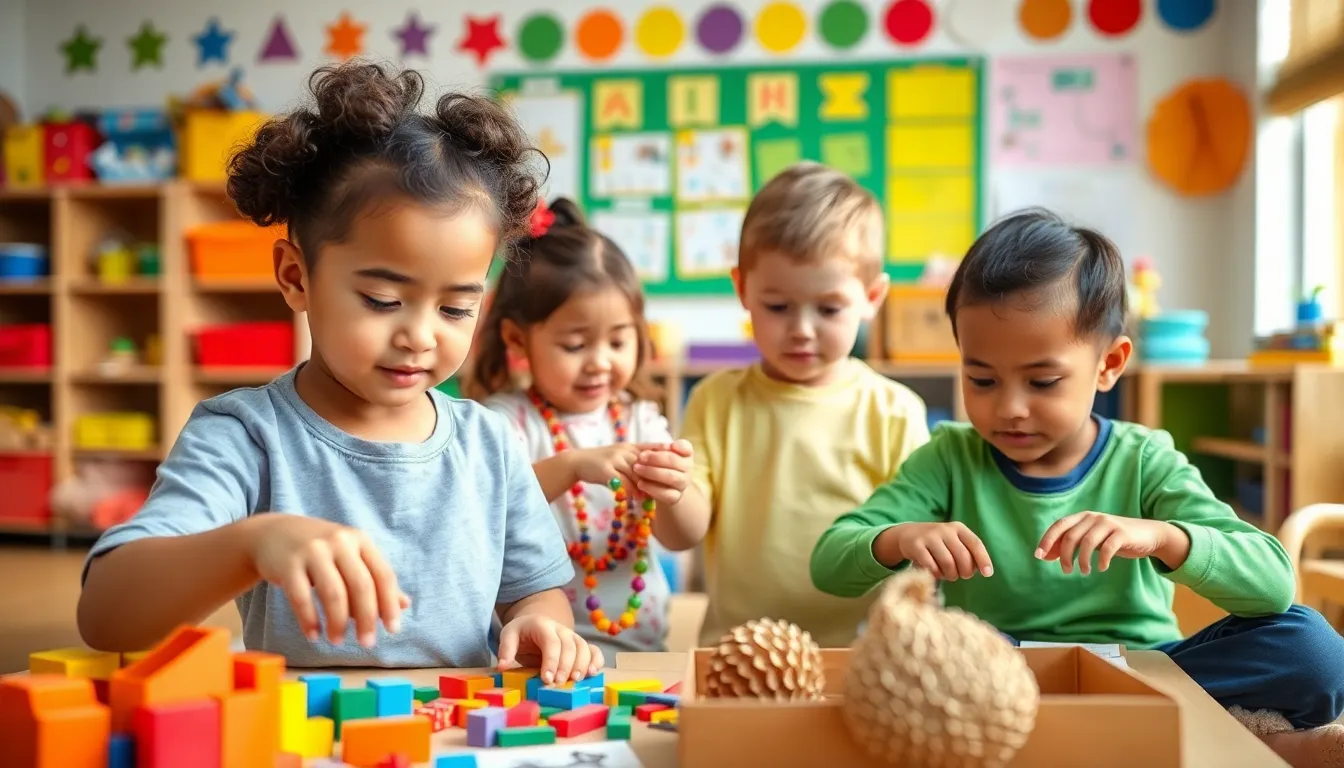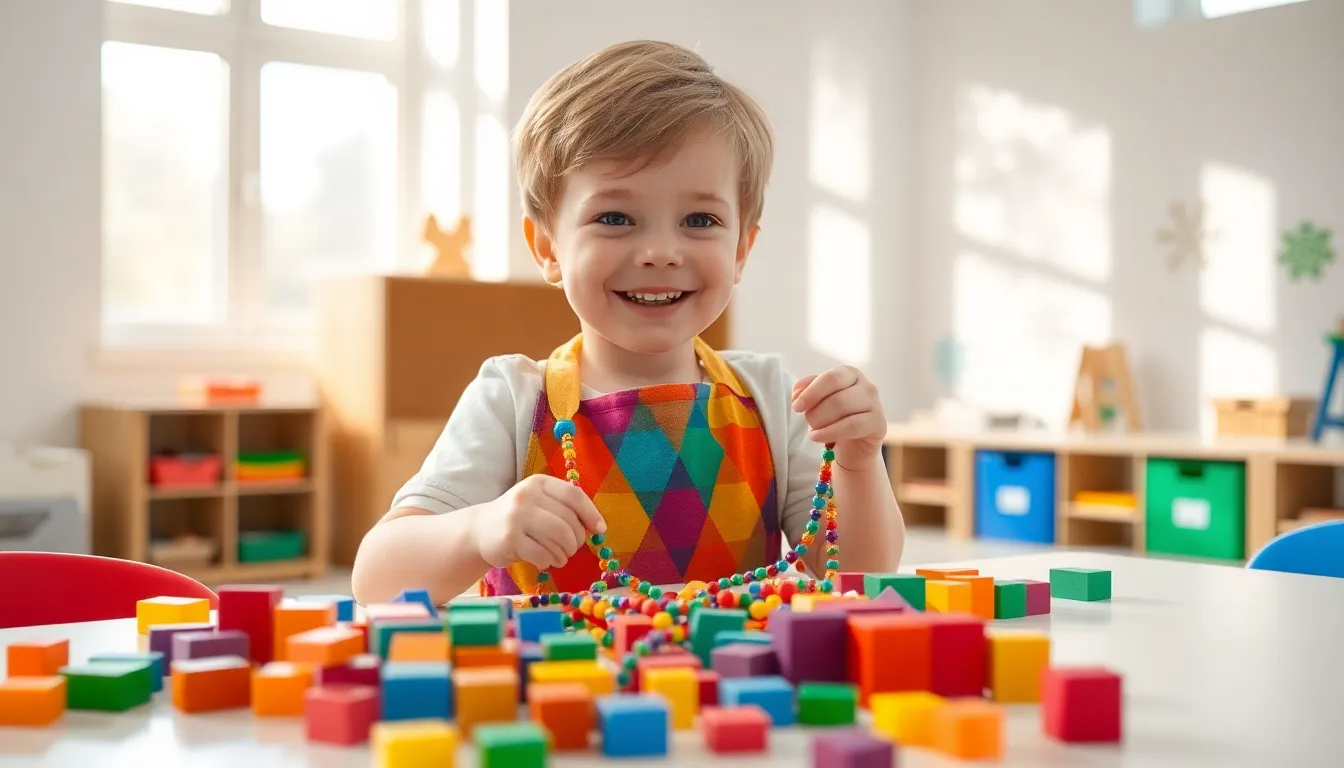Table of Contents
TogglePatterns are everywhere, from the stripes on a zebra to the spots on a ladybug. For preschoolers, discovering these patterns can feel like finding hidden treasure in a world full of colors and shapes. Engaging in pattern activities not only sparks their creativity but also lays the groundwork for essential math skills. Who knew that making a necklace from colorful beads could be a sneaky way to teach sequencing?
Importance Of Pattern Activities For Preschoolers
Engaging in pattern activities fosters critical cognitive development in preschoolers. Young children learn to identify and create patterns, strengthening their observational skills. These activities enhance problem-solving abilities as kids figure out the next item in a sequence.
Pattern recognition plays a vital role in math readiness. Simple tasks like sorting colored blocks or matching shapes introduce foundational math concepts. Recognizing patterns contributes to early arithmetic skills, including addition and subtraction.
In addition to math, pattern activities bolster language development. Children learn vocabulary related to colors, shapes, and sequences, enriching their communication skills. When preschoolers discuss patterns with peers, they practice turn-taking and conversational skills.
Creativity thrives through pattern-related activities. Making bead necklaces or drawing patterns allows children to express themselves artistically. These creative outlets encourage fine motor skills and hand-eye coordination.
Social interaction enhances the benefits of pattern activities. Working in groups encourages collaboration and teamwork. When children share ideas and solutions, it builds a sense of community in the classroom.
Long-term academic success also benefits from early experiences with patterns. The skills learned through these activities form a strong foundation for future learning. As preschoolers engage with their environment, they become critical thinkers prepared for more complex concepts later on.
Types Of Pattern Activities

Engaging in various types of pattern activities enhances preschoolers’ learning experiences. They help young children develop critical skills needed for academic success.
Visual Patterns
Visual patterns involve recognizing sequences through colors, shapes, and sizes. Examples include sorting colored blocks into groups, creating bead necklaces with alternating colors, or making art projects using stencils. They encourage observation skills, as children notice similarities and differences. Using classroom materials, educators can guide preschoolers to identify patterns in nature, such as leaves or animal prints. Visual pattern activities support not only cognitive development but also fine motor skills when children manipulate objects.
Auditory Patterns
Auditory patterns focus on sounds and rhythms, enhancing listening skills. Singing songs with repetitive lyrics or clapping hands in rhythmic sequences fosters musical appreciation. Activities like echo games, where children imitate sounds made by a teacher, hone auditory discrimination. Listening to patterned stories or poems reinforces vocabulary and comprehension. Through these auditory experiences, preschoolers develop memory and attention, laying the groundwork for future language skills.
Tactile Patterns
Tactile patterns encourage learning through touch. Examples include using textured materials like fabric or sand to create patterned artwork. Engaging children in activities such as tracing shapes or building structures with blocks builds their understanding of spatial relationships. Sensory bins filled with objects of different textures promote exploration and creativity. Tactile pattern activities support fine motor skill development while enriching sensory experiences. These activities create opportunities for hands-on learning and collaboration among peers.
Benefits Of Engaging In Pattern Activities
Engaging preschoolers in pattern activities offers several significant benefits that support their overall development.
Cognitive Development
Cognitive development flourishes through pattern activities. Recognizing and creating patterns sharpens observational skills. Preschoolers learn problem-solving techniques while they identify relationships between objects. Activities like sorting colored blocks advance math readiness. Such experiences establish a foundation for critical thinking by enabling children to analyze and predict outcomes. Through consistent practice, preschoolers build essential skills for future academic challenges.
Motor Skills Improvement
Motor skills improvement occurs naturally during pattern activities. Manipulating beads or arranging blocks enhances fine motor skills. Grasping, stacking, and threading objects require coordination and precision, promoting dexterity. Activities often involve sensory experiences, allowing children to explore textures and shapes. As preschoolers engage tactilely, they strengthen hand-eye coordination. These improvements foster independence as they develop confidence in their physical abilities.
Creativity Enhancement
Creativity enhancement stems from engaging in diverse pattern activities. Children explore artistic expression through various mediums like art, music, and dance. Making unique patterns with colors and shapes stimulates imagination. Crafting necklaces from beads allows for personal expression while reinforcing design concepts. Engaging in these activities encourages innovative thinking and self-discovery. Ultimately, pattern activities nurture a sense of creativity that benefits overall growth.
Tips For Implementing Pattern Activities
Implementing pattern activities in preschool develops essential skills. Effective strategies make these experiences engaging and fun.
Choosing The Right Materials
Select varied materials to facilitate diverse pattern activities. Colorful beads, blocks, and natural items like leaves enhance visual and tactile experiences. Incorporate everyday objects such as buttons or ribbons for familiarization. Craft supplies, including paper and markers, support creativity during design tasks. Focus on accessibility; materials should be safe and appropriate for young children. Encourage exploration through open-ended resources, allowing for individual creativity.
Setting Up The Activity Space
Design a dedicated area for pattern activities to minimize distractions. Use tables or mats for structured group work or individual exploration. Organize materials in clear containers, promoting independence as children select resources. Arrange seating to foster collaboration and social interaction among peers. Incorporate visual aids, such as posters displaying examples of patterns, to inspire creativity. Ensure the space is inviting and accessible, making the most of freedom to explore and learn.
Engaging preschoolers in pattern activities offers a multitude of benefits that extend beyond basic learning. These activities not only enhance cognitive and motor skills but also foster creativity and independence. By exploring various types of patterns through hands-on experiences, children develop essential problem-solving abilities and improve their observational skills.
Implementing diverse materials and creating an inviting learning environment further enriches these experiences. As preschoolers discover the world of patterns, they build a strong foundation for future academic success while enjoying the process of learning. Ultimately, pattern activities serve as a vital tool in nurturing well-rounded, confident learners ready to take on new challenges.




